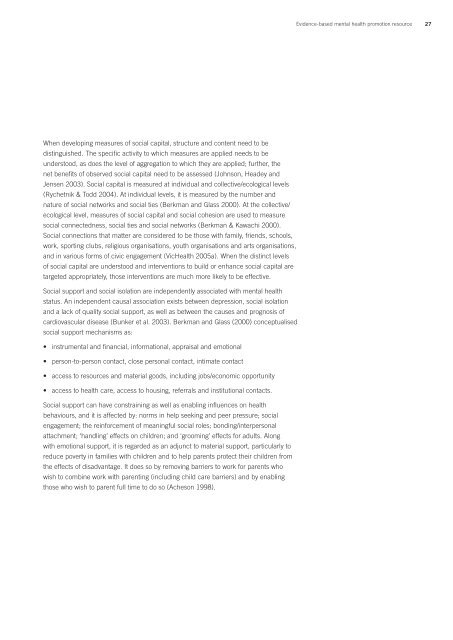Evidence-based mental health promotion resource - health.vic.gov.au
Evidence-based mental health promotion resource - health.vic.gov.au
Evidence-based mental health promotion resource - health.vic.gov.au
Create successful ePaper yourself
Turn your PDF publications into a flip-book with our unique Google optimized e-Paper software.
<strong>Evidence</strong>-<strong>based</strong> <strong>mental</strong> <strong>health</strong> <strong>promotion</strong> <strong>resource</strong>27When developing measures of social capital, structure and content need to bedistinguished. The specific activity to which measures are applied needs to beunderstood, as does the level of aggregation to which they are applied; further, thenet benefits of observed social capital need to be assessed (Johnson, Headey andJensen 2003). Social capital is measured at individual and collective/ecological levels(Rychetnik & Todd 2004). At individual levels, it is measured by the number andnature of social networks and social ties (Berkman and Glass 2000). At the collective/ecological level, measures of social capital and social cohesion are used to measuresocial connectedness, social ties and social networks (Berkman & Kawachi 2000).Social connections that matter are considered to be those with family, friends, schools,work, sporting clubs, religious organisations, youth organisations and arts organisations,and in various forms of ci<strong>vic</strong> engagement (VicHealth 2005a). When the distinct levelsof social capital are understood and interventions to build or enhance social capital aretargeted appropriately, those interventions are much more likely to be effective.Social support and social isolation are independently associated with <strong>mental</strong> <strong>health</strong>status. An independent c<strong>au</strong>sal association exists between depression, social isolationand a lack of quality social support, as well as between the c<strong>au</strong>ses and prognosis ofcardiovascular disease (Bunker et al. 2003). Berkman and Glass (2000) conceptualisedsocial support mechanisms as:• instru<strong>mental</strong> and financial, informational, appraisal and emotional• person-to-person contact, close personal contact, intimate contact• access to <strong>resource</strong>s and material goods, including jobs/economic opportunity• access to <strong>health</strong> care, access to housing, referrals and institutional contacts.Social support can have constraining as well as enabling influences on <strong>health</strong>behaviours, and it is affected by: norms in help seeking and peer pressure; socialengagement; the reinforcement of meaningful social roles; bonding/interpersonalattachment; ‘handling’ effects on children; and ‘grooming’ effects for adults. Alongwith emotional support, it is regarded as an adjunct to material support, particularly toreduce poverty in families with children and to help parents protect their children fromthe effects of disadvantage. It does so by removing barriers to work for parents whowish to combine work with parenting (including child care barriers) and by enablingthose who wish to parent full time to do so (Acheson 1998).



